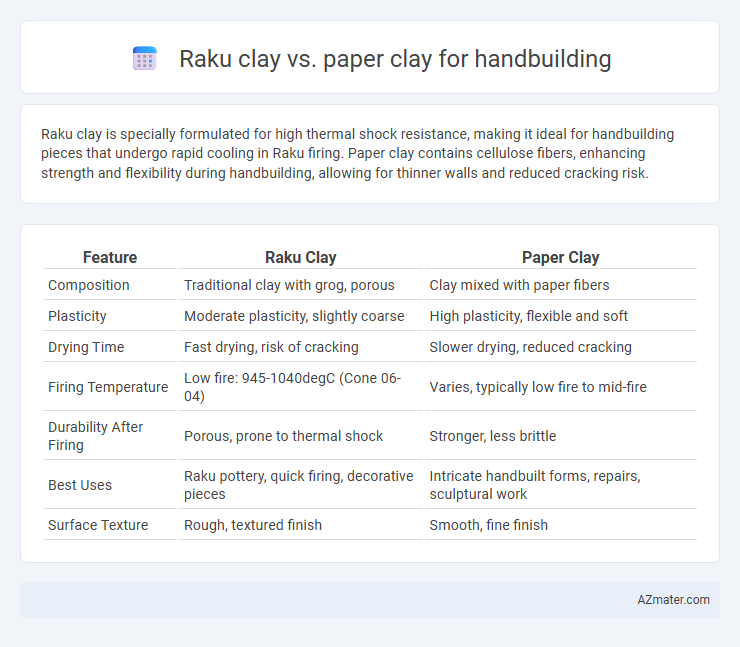Raku clay is specially formulated for high thermal shock resistance, making it ideal for handbuilding pieces that undergo rapid cooling in Raku firing. Paper clay contains cellulose fibers, enhancing strength and flexibility during handbuilding, allowing for thinner walls and reduced cracking risk.
Table of Comparison
| Feature | Raku Clay | Paper Clay |
|---|---|---|
| Composition | Traditional clay with grog, porous | Clay mixed with paper fibers |
| Plasticity | Moderate plasticity, slightly coarse | High plasticity, flexible and soft |
| Drying Time | Fast drying, risk of cracking | Slower drying, reduced cracking |
| Firing Temperature | Low fire: 945-1040degC (Cone 06-04) | Varies, typically low fire to mid-fire |
| Durability After Firing | Porous, prone to thermal shock | Stronger, less brittle |
| Best Uses | Raku pottery, quick firing, decorative pieces | Intricate handbuilt forms, repairs, sculptural work |
| Surface Texture | Rough, textured finish | Smooth, fine finish |
Introduction to Raku Clay and Paper Clay
Raku clay is a porous, low-fire clay body designed to withstand the rapid thermal shocks of the raku firing process, making it ideal for handbuilding techniques that require durability during reduction cooling. Paper clay incorporates cellulose fibers, enhancing flexibility and reducing cracking during drying, which benefits intricate handbuilt sculptures and allows for joining dry to wet surfaces. Both clays offer unique properties: Raku clay excels in thermal resistance for firing, while paper clay provides improved workability and repairability during the construction phase.
Composition and Ingredients
Raku clay primarily consists of grog and coarse particles that enhance thermal shock resistance, making it ideal for rapid firing and cooling processes typical in raku pottery. Paper clay integrates cellulose fibers, such as paper pulp, mixed into the clay body to improve flexibility, reduce cracking, and allow for easier joining of wet and dry pieces during handbuilding. The distinct composition of paper clay supports delicate, complex forms, while raku clay's mineral and grog content provides durability against high-temperature firing.
Workability and Texture
Raku clay offers a coarse, porous texture ideal for creating rustic handbuilt pottery that withstands thermal shock during firing. Paper clay contains cellulose fibers, enhancing flexibility and reducing cracking, which significantly improves workability for intricate handbuilding techniques. Both clays enable unique artistic effects, but paper clay provides smoother surfaces and easier manipulation compared to the rougher, more rigid feel of raku clay.
Drying and Shrinkage Rates
Raku clay typically has a higher drying shrinkage rate, around 6-10%, due to its coarse grog content, which helps reduce warping during rapid drying but demands careful moisture control. Paper clay incorporates cellulose fibers, significantly lowering drying shrinkage to approximately 3-5% and allowing for more flexibility and reduced cracking during handbuilding. These differences make paper clay preferable for complex or delicate forms, while raku clay suits quicker firings but requires slower, more controlled drying to minimize deformation.
Strength and Durability
Raku clay, formulated with grog and organic materials, offers moderate strength and durability suitable for low-fire handbuilding techniques but remains porous and fragile after firing. Paper clay incorporates cellulose fibers that significantly enhance strength and plasticity, allowing thinner, more resilient forms that dry harder and resist cracking better than traditional clays. For handbuilding projects requiring high durability and structural integrity, paper clay outperforms raku clay by providing increased tensile strength and improved resistance to mechanical stress.
Firing Temperatures and Techniques
Raku clay, typically fired between 1,650degF and 1,830degF (900degC to 1,000degC), withstands rapid cooling and reduction techniques essential to raku firing, yielding unique surface effects through thermal shock and post-firing reduction. Paper clay, composed of clay mixed with cellulose fibers, is more flexible for handbuilding but often requires bisque firing around 1,650degF (900degC) before glaze firing at moderate temperatures; it doesn't endure the thermal shock of raku firing as well. Choosing between them depends on the desired firing process: paper clay suits slower, conventional firings with better greenware strength, while raku clay is engineered for fast, low-temperature raku firing with immediate post-firing reduction.
Surface Finishes and Decoration
Raku clay offers a porous surface ideal for absorbing glazes, resulting in vibrant, crackled textures perfect for dynamic surface finishes in handbuilding. Paper clay incorporates cellulose fibers, enhancing tensile strength and enabling thinner walls while providing a matte, textured finish conducive to detailed surface decoration. Both clays respond differently to surface treatments: Raku clay excels in reactive glaze effects, whereas paper clay supports intricate carving and added surface embellishments.
Repairability and Flexibility
Raku clay offers high repairability during handbuilding, as its porous and slightly flexible texture allows for easy reattachment of broken pieces before firing. Paper clay incorporates cellulose fibers, enhancing flexibility and strength, making repairs seamless and less prone to cracking throughout the drying and firing process. The added paper fibers in paper clay improve elasticity, reducing flaws and allowing for more intricate handbuilding techniques compared to traditional raku clay.
Environmental Impact and Sustainability
Raku clay and paper clay differ significantly in environmental impact and sustainability; raku clay involves firing techniques that can release harmful fumes and consumes more energy due to high-temperature firing processes. Paper clay incorporates recycled paper fibers, reducing waste and lowering raw material consumption, which enhances its eco-friendliness and supports sustainable pottery practices. Choosing paper clay for handbuilding minimizes environmental footprint by promoting resource efficiency and reducing kiln emissions compared to traditional raku clay.
Choosing the Right Clay for Handbuilding
Raku clay offers high thermal shock resistance and porosity, making it ideal for firing techniques that require rapid cooling, while paper clay enhances strength and flexibility by incorporating cellulose fibers, reducing cracking during handbuilding. When choosing the right clay for handbuilding, consider raku clay for projects needing durability in firing and paper clay for delicate, intricate forms that benefit from improved plasticity and drying strength. Evaluating factors such as firing temperature, desired texture, and workability ensures optimal results tailored to specific handbuilding techniques.

Infographic: Raku clay vs Paper clay for Handbuilding
 azmater.com
azmater.com